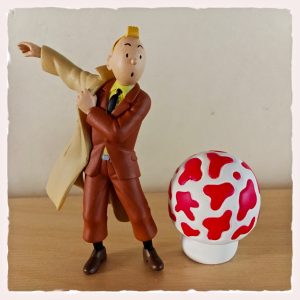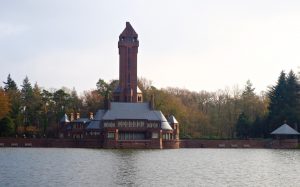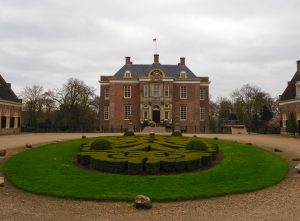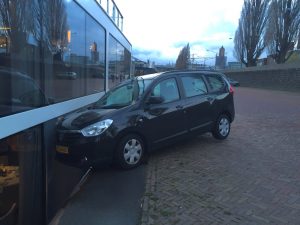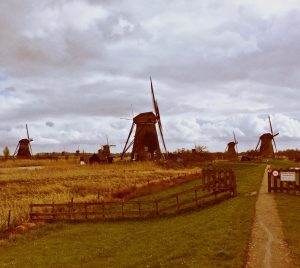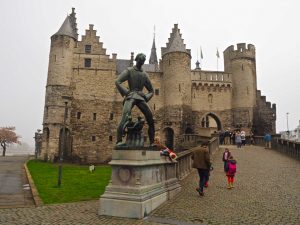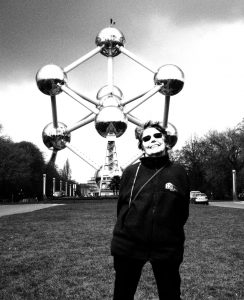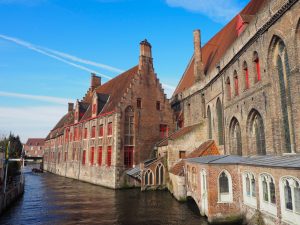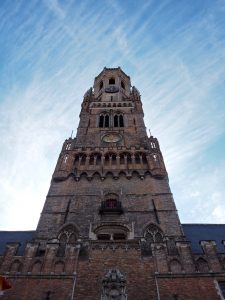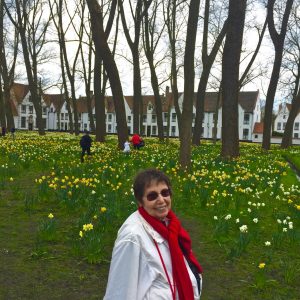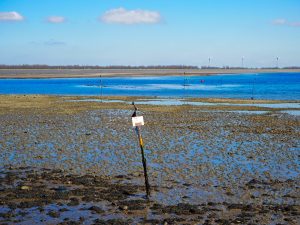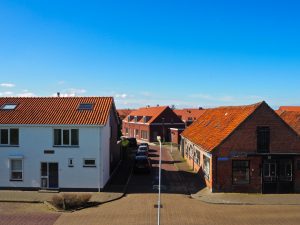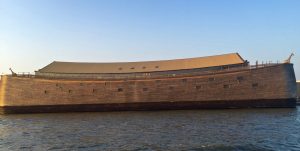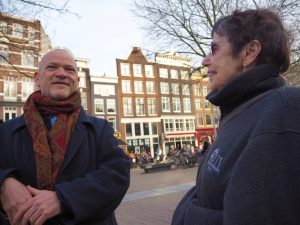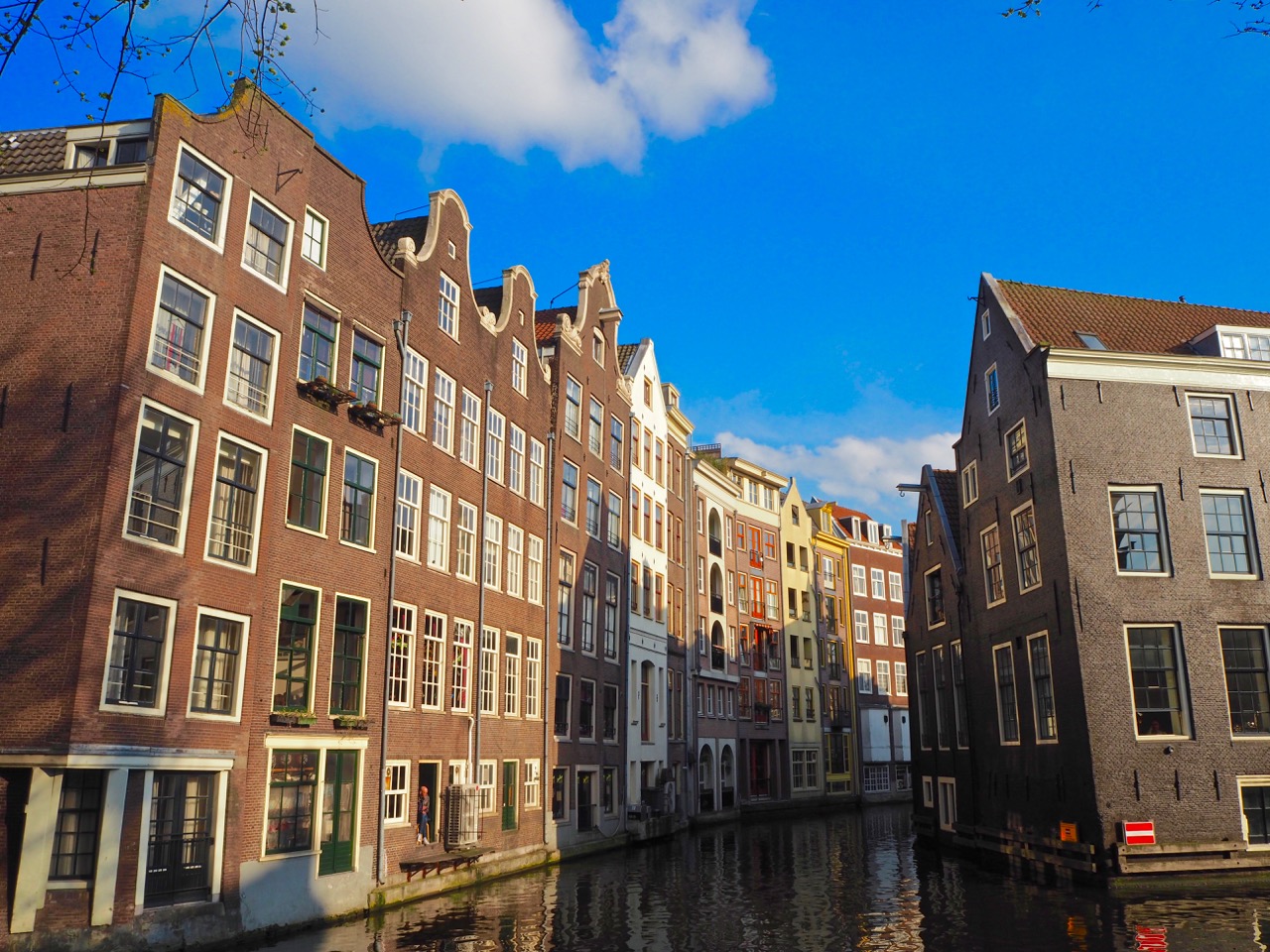
23 Apr I Need A NAP
Back home I am, Gentle Reader(s) after many a long mile logged by land, sea (or river), and air. They say that travel enlarges the mind, and though I have no doubt that They are correct in this assessment, travel can fatigue the mind and body as well. Particularly in the case of international travel when more than just a few time zones are involved. There is an eight hour time difference betwixt and between Santa Fe and Amsterdam and by the time I got home I was feeling every second of it. I like to think of myself as zipping and zooming energetically about the planet much in the manner of my ageless hero Tintin (there he is in effigy below, as purchased at the beautiful Tintin boutique in Brussels), but this trip did, in the end, manage to deal out a bit of an ass whuppin of the jet laggy variety. There were extenuating circumstances in the final chapter (I’ll not belabor you with that), but for all of the beautiful things I saw and the adventures I had with Inky Mum it is always good to get back home again. Now that I think of it, it was remiss of me not to acquire an effigy of Snowy to go with my Tintin—I think I was distracted by the neato giant mushroom from The Shooting Star. Darn the luck—I’ll just have to go back.
To pick up from the preceding narrative, after departing the lovely Hoorn and our hostess, the equivalently lovely Alette, we set sail south and east, back across the Markermeer past Amsterdam on our way to our next destination, Arnhem. Arnhem was one of our ports of call where the good ship Skirnir was moored in a somewhat less than salubrious locale, alongside a shabby industrial zone populated with derelict buildings and questionable looking wharf-side businesses (in other words, the type of locale that I tend to favor). However, just upriver from the ship was a not overly distinguished bridge over the Rhine that somehow seemed significant. I recalled that Arnhem was the location of an important World War II battle and our inestimable Programme Director, David, confirmed for us that the nearby bridge was indeed the John Frost Bridge, the very same titular structure that figures in the book and film A Bridge Too Far. The significance was not lost on yours truly and while I would have loved to taken some time to have a closer look we were signed up for both morning and afternoon activities. Add in meals and scant opportunity remained for additional wanderings. I mean, after all, one must eat, right?
The activities scheduled for that day commenced with a visit to the Kröller-Müller Museum in nearby Otterlo. Now, museums are something that I can say that I know a thing or two about. I’ve been to my share, near and far, including some of the greatest. I had never heard of the Kröller-Müller before and my delight in making the acquaintance of this wonderful institution was thereby doubled. It is situated in the midst of a vast national park formed from the land holdings of the Kröller-Müller family. Mme. Helene Kröller-Müller was the driving force behind the family’s art acquisitions and she was buying aggressively back in the day of what we in the art business (and by the ‘business’ I mean the ‘industry’) refer wistfully to as The Days of Low Hanging Fruit. Mme. Helene was one of the first to recognize the genius of her countryman Vincent Van Gogh and she purchased some stellar examples of his work back when Vinnie’s eponymous museum in Amsterdam was scarcely a glimmer in anyone’s eye. By just about any measure the Van Gogh Museum is well worth a visit but they did not have any examples as magnificent as Cafe Terrace at Night, 1888, or Country Road in Provence by Night, 1890. Van Gogh is undoubtedly one of the most over-exposed artists in the world but there is no denying the beauty and passion of works such as these. Mme. K-M purchased 90 works by Van Gogh and that group would probably make a worthy museum of its own, but the collection extends far beyond Vinnie and includes absolute masterpieces by Seurat, Mondrian, Juan Gris, Redon and dozens of others. I could have gladly spent the rest of the day there and we didn’t even have a chance to wander the extensive sculpture gardens surrounding the beautiful Henry van de Velde-designed museum. Mme. Helene scarcely lived to see her museum (it opened in 1938 and she passed away the following year) but the extraordinary hunting lodge she built and lived in is situated nearby, just beside a lake in the shape of a swan (or a rather Miro-esque abstract representation of a swan)—an aspect that can be fully appreciated only from either an airplane or from the top of the lodge’s tower, where Mme. K-M took her daily tea. Our guide informed us that the great lady utilized her private elevator to attain the summit of the tower while her maid had to carry the tea up the stairs.
We boarded our motor coach back to the good ship Skirnir and the John Frost Bridge and as we drove away from the museum our guide cued up Don McLean’s song Vincent from his classic 1971 album American Pie. It’s a lovely song, one of the best about any artist, and it was very nice indeed to hear it again. Then the guide skipped to the album’s title track and before you could say ‘Holy wooden shoes, Batman!’ I was riding through the Dutch countryside with a busload of septua- and octogenarians singing lustily along to the song’s ‘Bye bye Miss American Pie/Drove my Chevy to the levee but the levee was dry‘ chorus. The experience was… singular, I must say.
After lunch, our afternoon excursion was to the castle of Middachten and its orangerie, situated just outside of Arnhem in the village of De Steeg. Middachten is a family-owned and family-operated castle (not one of those questionable corporate franchise castles one sees along the interstate) and there has been a castle on this spot since the late 12th century. The current structure dates to the late 17th century and it is complete with stables, granary, and the obligatory moat in which paddled the obligatory swan. The extensive gardens were designed after Versailles, albeit on a much more modest scale, but at this time of year they had not yet begun to bloom. This rather tempered their appeal and the steady rain in which we toured them did little to enhance the experience. The rain did little to dampen the enthusiasm of our energetic guide, however, as typical Dutch weather is apparently a close relative of typical English weather, meaning fairly dreadful a fair portion of the time.
Seeing how the other half lives is one thing but usually that half isn’t living in the family castle surrounded by the family moat and the family doesn’t include people like King William III, Prince of Orange, and his Queen Mary (yes, that William and Mary). This was their half. Despite what one might have seen on Downton Abbey, life in a castle didn’t look overly inviting to me, although the family quarters upstairs may well have been very cosy. The thing that thrilled me no end was to see a family of storks—the family storks—nesting atop one of the chimneys. I could have stood in the rain all afternoon watching them fly in and out with thatch for the nest—that to me is pure magic.
The day was concluded back aboard the Skirnir where, just as dinner was finishing up, a loud BANG was heard in the dining room. It certainly caught my attention but many of my fellow diners had apparently left their ear trumpets in their staterooms and hardly anyone else seemed to notice. After a moment some folks at the far end of the dining room along the starboard side of the ship started jumping up from their tables and peering through the curtains, cellphones in hand. Apparently a lady driving her van along the dock somehow managed to smash into the side of the ship, totally shattering one of the double-paned ceiling-to-floor dining room windows. How one can manage to crash a van into a four-story high ship about the length of a football field, I have no idea, but she did it. Had she been going a bit faster there could have been a genuine calamity as she would have landed right on some unfortunate Viking’s table. More amazing still, when we arose for breakfast the following morning the damaged glass had been repaired–no indication whatsoever that anything had ever been amiss. How did they do it? I have no idea. I doff my chapeau to you, Viking engineering crew. Color me impressed.
The Skirnir did a lot of its sailing at night and we often cast off in the wee hours of the morning. Now, Your Humble Narrator is a light sleeper and when we set sail on mornings like this, at 4:00 AM, it inevitably woke me up. My stateroom being slightly below the water line, all the sounds of the waterways that we were traversing were transmitted through the water, through the ship’s double hull, into my stateroom, and into my wakeful skullington. The hull was also filled with varying levels of ballast water throughout our voyage and when it was largely empty you could hear the water sloshing about. Passing boats and ships added loud hums and rumbles to the mix and locks were characterized by roaring sounds and strange sonar-like pinging. I’m thinking it was probably quite a bit quieter on the upper decks and I got my best sleep when the Skirnir remained docked at night and sailed during the day.
Day five of our voyage meant it was time for… Windmill Porn! Yeah baby! Kinderdijk, at the confluence of the Lek and Noord rivers, was the name of the game and we docked right across from the village’s impressive array of classic 18th century wind-powered technology, 19 windmills in all. These beauties weren’t sawing or grinding anything but rather pumping water from the surrounding lowlands (known as polders) into a central canal which, when the tide was low, emptied its water into the river by way of large Archimedes screws. Modern diesel-powered pumping stations were present at the head of the canal but, I must say, they don’t have quite the panache of the windmills. I visited one of them and found it to be quite cozy but I wondered if I’d ever be able to get any sleep inside a windmill on a windy night (the windmills weren’t actually doing their windmilly thing when I was there). It might seem like an odd consideration but I was still mildly sleep-deprived at this stage of the game. I fired off a bunch of windmill porn postcards and headed back to the ship for our 4:30 PM sailing time—something I was enthusiastic about since I was expecting a decent night’s sleep once we docked at our next destination…
Antwerp! This was one the places where the Skirnir docked at a vast industrial wharf outside of the city center. It was a secured area so I’m not sure if it was even possible to go out and walk about but it didn’t really matter as the busses for the city tour started loading up immediately after breakfast at 8:45 in the AM. Antwerp, on the River Scheldt, is the second biggest port in Europe (after Rotterdam) and the Germans bombed the hell out of it after it was liberated by the British in September, 1944. Being primarily interested in destroying the port, the old city was largely spared save for the occasional V1 or V2 rocket that went off course. It was a misty, gray morning and the city was insanely picturesque as the sun rose like a radioactive nickel right beside the spectacular spire of the Onze-Lieve-Vrouwekathedraal (see the Digital images page for that photo). Our guide led us from Scheldt-side into the old city and to the Grote Markt, which is an amazing public space (even if some of the old guild houses along one side are modern repros). The cathedral contains four major works by Rubens, although the great painter is actually buried in the the even more ornate St. James Church. As usual, I could have lingered much longer, but after all, one must eat, right?
The afternoon excursion was the Brussels city tour. As we know all too well, Brussels has had its share of trouble and tragedy of late and the first thing that all of our tour guides in Antwerp, Brussels and Bruges did was to thank us for coming. The notion of changing our plans had never been seriously considered and, in a way, Inky Mum and I felt it was our duty to Keep Calm and Carry On and I’m glad we did. As it turned out, much was afoot in Brussels the day we were there—Friday, April 8. This was the day that the third Brussels airport bomber, the ‘man in the hat,’ was captured, but we didn’t know that until later. Our bus stopped at the site of the 1958 World’s Fair and we were able to do photo ops with the amazing 335-foot Atomium towering in the background. I had once glimpsed this amazing structure in the distance from the train whilst in transit from Paris to Amsterdam to visit Brother JB and the Warrior Princess back in 2007, so it was a thrill to see it up close. We walked through a portion of the central city and while there was a distinct security presence in evidence it didn’t seem particularly intense except around the various government installations in the city, of which there are hundreds. The tour guide pointed out the sites of the recent bombings and I appreciated that they did not try to sugar coat what had happened in the city. Belgian chocolates were dutifully acquired and, of course, my pilgrimage to the Tintin boutique was a highlight.
The good ship Skirnir sailed through the night to our next destination, Ghent. Now I’ve heard tell that they’ve got an altarpiece of some sort in Ghent that’s considered to be a Very Big Deal (I believe that Hitler or Goering tried to purloin it at one point) but the excursion to Bruges made a tour of Ghent an either/or proposition and Bruges won out. We piled into the busses at 8:30 AM for the drive to Bruges, about an hour away. I was really looking forward to this particular excursion as Bruges sounded like a genuinely unique and magical place but little did I know that the magic would take the form that it did. We disembarked from our lovely Viking motor coaches on the perimeter of the old city as such monstrosities are wisely barred from entry. A public WC was situated at that disembarkation place and the Belgians are fairly adamant that you cross their palms with .50€ for the privilege of urinating in their fair country. Seems reasonable, I guess, and a body’s got to make a living somehow, right? The passengers on our bus, including Inky Mum, piled into the WC and dutifully handed over their .50€ to the attendant. We then proceeded to be guided into the city by our guide, whose guidance was quite good. About ten minutes into our trek, Inky Mum became concerned that she had left a personal item at the public WC along with her .50€. Once we reached the center of Bruges our guide was to indicate to our group a rallying point where, after three hours of precious free time, we were to rally for our return to the motor coaches and the good ship Skirnir. We had no choice but to continue into the city in order that we should know this rallying point, so we soldiered on through the obscenely picturesque winding streets of Bruges. The misplaced personal item at the WC would have to wait.
By the time we reached the Grote Markt the crowds had begun to emerge in their thousands. Bruges had appeared more or less deserted when we arrived but by 10:30 in the AM the streets and squares near the center of town were thronging with tourists, of which I, to my eternal ignominy, was one. Our guide dismissed us to pursue our own agendas and I immediately buttonholed him to advise him of our need to return to our arrival point to retrieve Inky Mum’s personal item. We consulted a map and with a vague notion of a route in mind Inky Mum and I dove back into the narrow, winding streets of Bruges. We did not dive into the canals—it was a bit too chilly for that. We eventually found the public WC and it turned out that the proprietor, who was having lunch with his family, was the only person I met on this entire trip who did not speak English. We searched through the stalls and Inky Mum’s personal item was not to be found. Admitting defeat, around we turned and marched vaguely back to the Grote Markt, navigating by way of occasional glimpses of the famous bell tower and the spire of the Church of Our Lady. By this time about half of our three free hours were up and it was time for lunch. After all, one must eat, right? We had a less than memorable meal in one of the less than memorable cafes across from the Provinciaal Hof and I recalled that our guide had warned us off of the restaurants on the Grote Markt. This was not the Grote Markt but it seemed that the cafes on the town’s squares were all clip joints to one degree or another.
After the day’s unexpectedly extended perambulations, there was not much time left to see the highlights of Bruge’s cultural offerings, including Michelangelo’s sculpture of the Madonna and child in the Church of Our Lady (another masterpiece that the Nazis tried to swipe) or the relics in the intriguingly named Basilica of the Holy Blood. I’ll just have to come back—that’s all there is to it. Inky Mum did some shopping while I stood out on the street and watched the world watch me as it went by and I stood in the street watching it… or words to that effect. We rallied back at the rallying point, joined our fellow Vikings, and marched meanderingly back to the busses, passing the Béguinage (in which no Beguines currently reside, but rather Benedictines) in front of which a grassy park was filled with a lovely blooming of daffodils. Inky Mum posed for photos and we left Bruges to motor coach back to Ghent. I have a feeling I shall return to Bruges but more likely at a time when the Viking cruises and other such touristic boondoggles are not in effect. Perhaps in the middle of a snow storm. That’s more my speed.
That evening our fearless and peerless Programme Director, David, presented the much-anticipated Music Quiz. There had been a quiz of the general knowledge variety a few evenings previous and the inhabitants of our dining table had banded together as the Golden Oldies (my long-prematurely gray hair apparently qualifying me for membership) to compete in this event. We came in second place but I assured my table-mates that the Music Quiz was a done deal—you can bank on it, we’ve already won. So the pressure was on, Gentle Reader(s), as the great event approached. The quiz was of the ‘name-that-tune’ sort in which David played snippets of the intros of songs and we wrote the titles down on a sheet. The eight of us—Philip and Pat (the Brits), Kris (or Chris?) and Jim, Barb, Sue, and YHN and Inky Mum—put our collective Euterpian knowledge to the test and ended up in—to my surprise—a four-way tie for first place. I represented the Golden Oldies in the tie-breaker, which David, in an unexpected twist, decided to make a current affairs question instead of a musical one. He advised us that the first to answer correctly was the winner. Being one for keeping fairly well-informed on goings-on about the planet, I felt confident. David began his question: ‘What secret documents revealed last week led to…’ I immediately blurted out ‘The Panama Papers!’ This was correct, but instead of the shower of praise and champagne that I was expecting, David hemmed and hawed for a second before saying that we would have to have another tie-breaker as I hadn’t waited until the end of the question to answer. Now, that was not part of the instruction for the tie-breaker and the Golden Oldies started howling in protest. Not wanting to be a spoil sport I demurred and David said we would do another ‘name-that-tune’ question instead. Again, I was feeling confident but when David pressed ‘Play’ on his iPad the intro was unfamiliar to me. A diminutive lady to my left yelled out ‘Mama Mia!’ and that was that, Gentle Reader(s). Mama Mia?!?! If there’s one group that I never paid any attention to whatsoever it is ABBA. We was robbed!! Oh well… I admitted defeat and returned to my fellow Golden Oldies a broken man. A great hue and cry went up and David was summoned to hear the adamant protestations of my faithful table-mates. He admitted that his instructions were not as clear as they might should have been but that there was a second part to the current events question—specifically, what country’s prime minister was forced to resign as a result of the Panama Papers. I knew that, too—Iceland—but what was done was done. We were awarded a bottle of champagne as a consolation prize and we toasted the winning group, gracious also-rans that we were.
This evening was another night sail and we cast off for our return to the Netherlands and the homeward-bound leg of our voyage. We arrived in the province of Zeeland, the southwestern-most region of the Netherlands, the following morning and moored up in a lovely suburban/rural setting for a change. Most encouragingly, the weather had finally cleared, the winds had diminished, the sun was shining and the skies were a brilliant blue. I had been waiting for this the entire trip and while the other Vikings toured off to see the vast delta works that keep the North Sea at bay, Inky Mum had a quiet day and I took to the dikes and pathways with camera in hand. The little town of Bruinisse was nearby and I was rather pleased to find that it was apparently of no major historical significance and seemed to date primarily from the early to mid 20th century—just a quiet little Dutch town, devoid of tourists, filled with people going to the market and attending church on a quiet, sunny Sunday morning. Dutch families of multiple generations—children, parents, grandparents—were out riding their bikes and walking their dogs along the paved pathways that topped the dikes and ran along the waterside. There were benches placed at pleasing spots along the way, public WCs were available at the harbor, and everything was clean, well maintained, and orderly. It’s amazing what a 50% tax rate and a bit of Socialism will do for a country.
I wandered down into Bruinisse, soon found a mailbox for my postcards and stood listening to people singing hymns in the church near the center of town. It was a wonderful experience, perhaps my favorite of the entire trip, and I really appreciated the opportunity to get a feel for Dutch life away from the touristic-thronged locales that were the primary focus of our voyage. I could have spent all day wandering, watching the ships go by, taking photographs of sheep grazing on the dikes, looking for leaks—it was a total joy. But the Skirnir was set to sail for Rotterdam at 1:45 and of course I had to be back in time for lunch. After all, one must eat, right?
It was finally a day for enjoying some top-side sailing so I went to the upper deck with a number of people to take advantage of the good weather. I had bought a six-pack of the local brew (Heineken) back in Amsterdam and stashed it in my refrigerator for just this occasion and Barb and I enjoyed a libation together as we set sail. Beautiful though the weather was, the winds picked up mightily once we headed into open water and I retreated to the partially shielded Aquavit Terrace at the prow of the ship to write and cogitate. A number of my shipboard acquaintances wandered by and everyone expressed amazement at my extensive scribbling. Being of an older generation I had thought that they’d be more attuned to the pleasures of the handwritten word but it seems that just about everyone is losing touch with pen and paper in this digital day and age. This, in fact, was the precise reason for my decision to send postcards while on this excursion. I supplied Inky Mum with postcards and stamps as well but, alas, she demurred and decided to keep the postcards instead.
The Skirnir went through locks regularly but this was the first time I was able to observe the entire process from the open deck. Viking Longships are designed to fit two, side by side, in these locks and they do so with remarkable precision, leaving but a few inches to spare on either side. There are rubber-cushioned bumpers on the sides of the boat and these often butt up right against the concrete sides of the locks and the neighboring ship. Viking ships are equipped with side-thrusters that allow them to maneuver very precisely, guided by pilots working from control panels resembling outdoor gas grills installed about mid-ship on both sides of the top deck. Again, color me impressed.
That evening we were to dock at Rotterdam and as we approached this largest port in Europe a bizarre sight hove into view off the starboard side of the ship: Noah’s Ark. Or rather Johan’s Ark—a contemporary reimagining of this most notable biblical vessel, the brainchild of a Dutch millionaire nut job, creationist variant, by the name of Johan Huibers. Quite a sight it is, Gentle Reader(s), and I suppose that it’s a good thing to keep in mind that the United States is not the only country to have its share of well-funded wack jobs. The rather comical looking giraffes positioned at either end of the vessel added to the surreal aspect of this vision. I questioned whether I should condescend to even take a photograph of this strange manifestation but in the end I couldn’t resist.
Night was falling by the time we arrived in Rotterdam and after dinner we went topside to take in the view of the city, which included a Calatrava bridge further downstream on the River Meuse and a number of interesting post-modern buildings. We decided to stay aboard the ship and start prepping for the end of our journey in two day’s time. At one point I happened to knock on the door of Inky Mum’s stateroom and when I entered I was surprised to see there a particular personal item that brought to mind our extensive hike through the streets of Bruges a couple of days previous. ‘I can’t help but notice your personal item there,’ I said to Inky Mum. ‘I have to ask—would that, by any chance, be the very same personal item that you had thought you left at the WC in Bruges?’ Inky Mum considered this for a moment and then replied in the affirmative. ‘So,’ I continued, ‘when you thought you had left this item in the WC and we walked all the way from the edge of town to the center and then back to the edge of town and back to the center again you never actually had it with you in the first place, correct?’ Inky Mum considered this proposition for a further moment and then replied again in the affirmative. ‘Well, we did have a very nice walk, didn’t we?’ she said. There was no arguing with that logic.
We set sail in the early morning hours for Amsterdam, docking just a short distance from our original departure point by the good old Movenpick Hotel. As we were having breakfast the groups began forming up for our voyage’s final excursion, to the Keukenhof Gardens, and Inky Mum rather wistfully mentioned that she had really wanted to see the extensive tulip gardens that were part of the namesake of our voyage (‘Tulips and Windmills’). We had not signed up for this particular excursion, figuring that we’d prefer to have a final free day in Amsterdam before we left. I said ‘Well, you can probably still go if you want to.’ Inky Mum continued to munch rather disconsolately on her bacon. ‘Do you want to go?’ I prodded. ‘Yes,’ allowed Inky Mum. ‘Well then, let’s go!’ I said. ‘Okay,’ said Inky Mum, continuing to munch. ‘NOW!’ I said. ‘Let’s go! Get up!’ I yelled up to David on the deck above to hold on for Inky Mum and we dashed down to her conveniently close stateroom to get her kitted up for the trip. I handed her over to the ministrations of David and our friend and table-mate Barb for the Keukenhof adventure, which involved an hour-long motor coach trip—something I simply wasn’t feeling up for (lest there be any more group singing involved).
This left me with a day on my own in one of my favorite cities so I headed out to a shop that makes bespoke gentlemen’s bags and leather goods, Property Of… in the Jordaan district. My goal accomplished, I made contact with Brother JB and we arranged to meet at the atelier that he shares with the Warrior Princess at the multi-use Volkshotel. The weather had held for another day and I had a nice long sunny walk through the central city, crossing through the Jordaan, Red Light, Golden Curve, Museum and De Pijp neighborhoods. JB and I had a very pleasant chat and tea in his atelier, discussing future projects and my eventual return to Amsterdam, which will undoubtedly happen. Inky Mum had returned to the Skirnir after a very enjoyable headlong dive into tulip-porn and Barb had sent an email inquiring as to my continued viability upon the planet. I said a fond farewell to Brother JB (see his portrait on the Analog page) and grabbed a cab back to the docks. One note about Amsterdam: The cabs are plentiful and easy to find and the drivers ALL speak more or less perfect English—something you’d be hard-pressed to find in just about any large city back in the States. Amsterdam taxis are not cheap though—probably a bit more expensive than New York—but they’re usually clean and well-maintained and the drivers polite, especially if you cross their palms with a euro or two tip. Be that as it may, my cabbie on this excursion came within centimeters of flattening a motorcyclist in an adjacent lane but no one got hurt.
Our final night on the Skirnir was spent having a tearful (almost) final dinner (after all, one must eat, right?), making our farewells, and preparing for an ungodly early departure to Schiphol Airport in the painfully wee small hours of the morning. Before dinner I managed to fit in one last solo excursion, this one across the Jan Schaefferbrug Bridge, next to which the Skirnir was moored, to an island in the harbor that was a former industrial zone since reclaimed and developed into public housing. Brother JB recommended it as a good example of what the Dutch concept is for these kinds of projects. In a manner quite unlike the US, each and every one of the buildings was distinctly different and I reflected on how, back in the land of unbridled individualism, sameness is so often the rule. The apartment houses looked quite pleasant indeed and there were gardens and green spaces inserted in just about every available spot of open ground. Interestingly, the canals that cut through the island were not fenced off or lined with railings and there were children running all about and zooming by on bicycles and skates. Now, in the US this would be unthinkable and I recalled what our guide in Bruges had told us. Noting that Americans frequently inquired how it was possible that the canals lacked fences or railings he said that the Dutch simply brought their children up to have good sense enough not to fall into them. Wow. Imagine that.

